What would a visit to Athens be without going to the Acropolis to see the Parthenon? And still people ask why the Partheon is so important. It’s because it was the most perfect building built by the world's most advanced civilization.
The Acropolis of Athens is the best known acropolis (Gr. akros, akron, edge, extremity + polis, city, pl. acropoleis) in the world. Although there are many other acropoleis in Greece, the significance of the Acropolis of Athens is such that it is commonly known as The Acropolis without qualification. The Acropolis was formally proclaimed as the pre-eminent monument on the European Cultural Heritage list of monuments on 26 March 2007. The Acropolis is a flat-topped rock which rises 150 m (490 ft) above sea level in the city of Athens, with a surface area of about 3 hectares. It was also known as Cecropia, after the legendary serpent-man, Kekrops or Cecrops, the first Athenian king.
The Acropolis rock is part of a Late Cretaceous limestone ridge (Higgins) that cuts through the Attica plateau in the northeast to the southwest axis and includes the Likavitos hill, the Philopappos (Museum) hill, the hill of the Nymphs, and the Pnyx.
The rock rises from the basin about 70 meters and levels to a flat top 300 meters long by 150 meters wide. Its flat top is due to the numerous landfills that have accommodated construction of fortifications and temples since the Mycenaean era. With its many shallow caves, the abundant percolating water springs and steep slopes, the Acropolis was a prime location for habitation and worship location for Neolithic man.
History
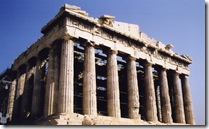 The greatest and finest sanctuary of ancient Athens, dedicated primarily to its patron, the goddess Athena, dominates the centre of the modern city from the rocky crag known as the Acropolis. The most celebrated myths of ancient Athens, its greatest religious festivals, earliest cults and several decisive events in the city's history are all connected to this sacred precinct. The monuments of the Acropolis stand in harmony with their natural setting. These unique masterpieces of ancient architecture combine different orders and styles of Classical art in a most innovative manner and have influenced art and culture for many centuries. The Acropolis of the fifth century BC is the most accurate reflection of the splendour, power and wealth of Athens at its greatest peak, the golden age of Pericles.
The greatest and finest sanctuary of ancient Athens, dedicated primarily to its patron, the goddess Athena, dominates the centre of the modern city from the rocky crag known as the Acropolis. The most celebrated myths of ancient Athens, its greatest religious festivals, earliest cults and several decisive events in the city's history are all connected to this sacred precinct. The monuments of the Acropolis stand in harmony with their natural setting. These unique masterpieces of ancient architecture combine different orders and styles of Classical art in a most innovative manner and have influenced art and culture for many centuries. The Acropolis of the fifth century BC is the most accurate reflection of the splendour, power and wealth of Athens at its greatest peak, the golden age of Pericles.
Most of the major temples were rebuilt under the leadership of Pericles during the Golden Age of Athens (460–430 BC). Phidias, a great Athenian sculptor, and Ictinus and Callicrates, two famous architects, were responsible for the reconstruction. During the 5th century BC, the Acropolis gained its final shape. After winning at Eurymedon in 468 BC, Cimon and Themistocles ordered the reconstruction of southern and northern walls, and Pericles entrusted the building of the Parthenon to Ictinus and Phidias.
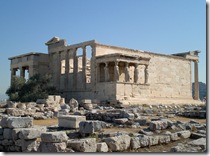 In 437 BC Mnesicles started building the Propylaea, monumental gates with columns of Pentelic marble, partly built upon the old propylaea of Pisistratus. These colonnades were almost finished in the year 432 BC and had two wings, the northern one serving as picture gallery. At the same time, south of the propylaea, building of the small Ionic Temple of Athena Nike commenced. After an interruption caused by the Peloponnesian War, the temple was finished in the time of Nicias' peace, between 421 BC and 415 BC.
In 437 BC Mnesicles started building the Propylaea, monumental gates with columns of Pentelic marble, partly built upon the old propylaea of Pisistratus. These colonnades were almost finished in the year 432 BC and had two wings, the northern one serving as picture gallery. At the same time, south of the propylaea, building of the small Ionic Temple of Athena Nike commenced. After an interruption caused by the Peloponnesian War, the temple was finished in the time of Nicias' peace, between 421 BC and 415 BC.
During the same period the building of the Erechtheum, a combination of sacred precincts including the temples of Athena Polias, Poseidon, Erechtheus, Cecrops, Herse, Pandrosos and Aglauros, with its so-called the Kore Porch (or Caryatids' balcony), was begun.
Between the temple of Athena Nike and the Parthenon there was the temenos of Artemis Brauronia or Brauroneion, the goddess represented as a bear and worshipped in the deme of Brauron. The archaic xoanon of the goddess and a statue made by Praxiteles in the 4th century BC were both in the sanctuary.
Behind the Propylaea, Phidias' gigantic bronze statue of Athena Promachos ("she who fights in the front line"), built between 450 BC and 448 BC, dominated. The base was 1.50 m high, while the total height of the statue was 9 m. The goddess held a lance whose gilt tip could be seen as a reflection by crews on ships rounding Cape Sounion, and a giant shield on the left side, decorated by Mys with images of the fight between the Centaurs and the Lapiths. Other monuments that have left almost nothing visible to the present day are the Chalkotheke, the Pandroseion, Pandion's sanctuary, Athena's altar, Zeus Polieus's sanctuary and, from Roman times, the circular temple of Augustus and Rome.
Site Monuments
Parthenon
 The Parthenon, dedicated by the Athenians to Athena Parthenos, the patron of their city, is the most magnificent creation of Athenian democracy at the height of its power. It is also the finest monument on the Acropolis in terms of both conception and execution. Built between 447 and 438 BC, as part of the greater Periklean building project, this so-called Periklean Parthenon (Parthenon III) replaced an earlier marble temple (Parthenon II), begun a
The Parthenon, dedicated by the Athenians to Athena Parthenos, the patron of their city, is the most magnificent creation of Athenian democracy at the height of its power. It is also the finest monument on the Acropolis in terms of both conception and execution. Built between 447 and 438 BC, as part of the greater Periklean building project, this so-called Periklean Parthenon (Parthenon III) replaced an earlier marble temple (Parthenon II), begun a
after the victory at the battle of Marathon at approximately 490 BC and destroyed by the Persians in 480 BC. This temple had replaced the very first Parthenon (Parthenon I) of c. 570 BC. The Periklean Parthenon was designed by architects Iktinos and Kallikrates, while the sculptor Pheidias supervised the entire building program and conceived the temple's sculptural decoration and chryselephantine statue of Athena.
Erechtheion Propylaea Temple of Athena Nike Temple of Rome and Augustus The temple of Rome and Augustus was erected in the late first century BC east of the Parthenon or of the Erechtheion. Several architectural elements of the building were found east of the Parthenon and many more were brought here after their discovery elsewhere. Nearby are the irregular tufa foundations (approximately 10.50x13 metres) of a building generally considered to be the Roman temple. Another theory, however, based on the construction technique of these foundations and on depictions of the Acropolis on Roman coins, places the temple east of the Erechtheion. The inscription on the temple's epistyle mentions that the building was dedicated by the city of Athens to the goddess Rome and to Octavian Augustus. Pausanias does not mention the building during his visit to the Acropolis, possibly because it did not present any interest at his time. The small, circular temple had a single row of nine Ionic columns and no interior wall, the entablature and conical roof being entirely of white marble. The fact that the columns imitate those of the Erechtheion may indicate that the temple was built by the same architect who repaired the Erechtheion after it was damaged by fire. Old temple of Athena The Old temple was a Doric, peripteral structure with six columns on the short sides and twelve on the long sides. The interior arrangement was quite unusual. The east part of the temple consisted of a distyle pronaos with antae and a naos divided into three naves by two rows of columns. Inside the naos was the wooden cult statue (xoanon) of the goddess Athena. The east part of the temple consisted of three rooms, each dedicated to the worship of Poseidon-Erechtheus, Hephaistus and Boutes. The marble pediments of the Gigantomachy, displayed in the Acropolis Museum, and a sime with lion and ram's heads probably belonged to this temple. The metopes, cornices and roof tiles were also of marble, while the rest of the temple was built of limestone. The temple was unearthed in 1885 and W. D?rpfeld was the first to identify it. Only the foundations of its south side, towards the Erechtheion, are visible today, along with two stone column bases from the Geometric temple.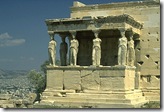 The elegant building known as the Erechtheion, on the north side of the sacred rock of the Acropolis, was erected in 421-406 BC as a replacement of an earlier temple dedicated to Athena Polias, the so-called ''Old temple''. The name ''Erechtheion'', mentioned only by Pausanias (1, 26, 5), derives from Erechtheus, the mythical king of Athens, who was worshipped there. Other texts refer to the building simply as ''temple'' or ''old temple''. The building owes its unusual shape to the irregularity of the terrain - there is a three-metre difference in height between the eastern and western parts - and the multiple cults it was designed to accommodate. The eastern part of the building was dedicated to Athena Polias, while the western part served the cult of Poseidon-Erechtheus and held the altars of Hephaistus and Voutos, brother of Erechtheus. This is where, according to the myth, Athena's sacred snake lived. The sanctuary also contained the grave of Kekrops and the traces of the dispute between Athena and Poseidon for the possession of the city of Athens.
The elegant building known as the Erechtheion, on the north side of the sacred rock of the Acropolis, was erected in 421-406 BC as a replacement of an earlier temple dedicated to Athena Polias, the so-called ''Old temple''. The name ''Erechtheion'', mentioned only by Pausanias (1, 26, 5), derives from Erechtheus, the mythical king of Athens, who was worshipped there. Other texts refer to the building simply as ''temple'' or ''old temple''. The building owes its unusual shape to the irregularity of the terrain - there is a three-metre difference in height between the eastern and western parts - and the multiple cults it was designed to accommodate. The eastern part of the building was dedicated to Athena Polias, while the western part served the cult of Poseidon-Erechtheus and held the altars of Hephaistus and Voutos, brother of Erechtheus. This is where, according to the myth, Athena's sacred snake lived. The sanctuary also contained the grave of Kekrops and the traces of the dispute between Athena and Poseidon for the possession of the city of Athens.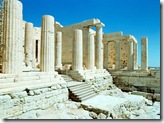 The Propylaia of the Athenian Acropolis were built on the west side of the hill, where the gate of the Mycenaean fortification once stood. The first propylon, or gate, was constructed in the age of Peisistratos (mid-sixth century BC), after the Acropolis had become a sanctuary dedicated to Athena. A new propylon, built in 510-480 BC, was destroyed by the Persians in 480 BC and repaired after the end of the Persian Wars, during the fortification of the Acropolis by Themistokles and Kimon. The monumental Propylaia admired by modern visitors were part of the great Periklean building program. They were erected in 437-432 BC, after the completion of the Parthenon, by architect Mnesikles. The original building plan was particularly daring both in architectural and artistic terms, but was never completed.
The Propylaia of the Athenian Acropolis were built on the west side of the hill, where the gate of the Mycenaean fortification once stood. The first propylon, or gate, was constructed in the age of Peisistratos (mid-sixth century BC), after the Acropolis had become a sanctuary dedicated to Athena. A new propylon, built in 510-480 BC, was destroyed by the Persians in 480 BC and repaired after the end of the Persian Wars, during the fortification of the Acropolis by Themistokles and Kimon. The monumental Propylaia admired by modern visitors were part of the great Periklean building program. They were erected in 437-432 BC, after the completion of the Parthenon, by architect Mnesikles. The original building plan was particularly daring both in architectural and artistic terms, but was never completed.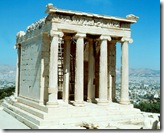 The temple of Athena Nike stands at the southeast edge of the sacred rock atop a bastion, which in Mycenaean times protected the entrance to the Acropolis. The Classical temple, designed by architect Kallikrates and built in 426-421 BC, succeeded earlier temples also dedicated to Athena Nike. The first one of these, a mid-sixth century BC wooden temple was destroyed by the Persians in 480 BC. The eschara, the altar believed to have supported the cult statue of the goddess, dates to this period. Under Kimon, c. 468 BC, a small temple of tufa was erected around the base of the statue and a new altar was built outside the temple. The foundations of these early temples and altars are preserved inside the bastion under the floor of the Classical structure. Pausanias (1, 22, 4) refers to this temple as that of the Apteros Nike, or Wingless Victory, and mentions that the cult statue of the goddess had no wings so that she would never leave Athens. Apart from the cult of Athena Nike other, earlier cults were also practiced on this site. On the west side of the bastion was a Mycenaean double-apsed shrine and on the east side, the pre-Classical shrines of the Graces and of Hekate Epipyrgidia. The construction of the Classical temple of Athena Nike was part of the Periklean building project. Several inscriptions, mostly decrees of the city of Athens, provide information on this particular part of the project.
The temple of Athena Nike stands at the southeast edge of the sacred rock atop a bastion, which in Mycenaean times protected the entrance to the Acropolis. The Classical temple, designed by architect Kallikrates and built in 426-421 BC, succeeded earlier temples also dedicated to Athena Nike. The first one of these, a mid-sixth century BC wooden temple was destroyed by the Persians in 480 BC. The eschara, the altar believed to have supported the cult statue of the goddess, dates to this period. Under Kimon, c. 468 BC, a small temple of tufa was erected around the base of the statue and a new altar was built outside the temple. The foundations of these early temples and altars are preserved inside the bastion under the floor of the Classical structure. Pausanias (1, 22, 4) refers to this temple as that of the Apteros Nike, or Wingless Victory, and mentions that the cult statue of the goddess had no wings so that she would never leave Athens. Apart from the cult of Athena Nike other, earlier cults were also practiced on this site. On the west side of the bastion was a Mycenaean double-apsed shrine and on the east side, the pre-Classical shrines of the Graces and of Hekate Epipyrgidia. The construction of the Classical temple of Athena Nike was part of the Periklean building project. Several inscriptions, mostly decrees of the city of Athens, provide information on this particular part of the project.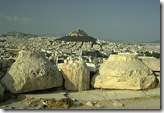 The earliest temple to Athena Polias on the Acropolis, called 'the Old temple' in ancient literary sources, was located between the Erechtheion and the Parthenon. It was probably built in the third quarter of the sixth century BC, on the site of an earlier, Geometric temple and of the even earlier Mycenaean palace. The Old temple was damaged by the Persians in 480 BC, but was repaired soon after; parts of its entablature were incorporated in the Acropolis fortification wall. The temple was damaged again in 406 BC after the completion of the Erechtheion and was never rebuilt. Traces of the temple's altar to Athena are visible on the bedrock, east of the building.
The earliest temple to Athena Polias on the Acropolis, called 'the Old temple' in ancient literary sources, was located between the Erechtheion and the Parthenon. It was probably built in the third quarter of the sixth century BC, on the site of an earlier, Geometric temple and of the even earlier Mycenaean palace. The Old temple was damaged by the Persians in 480 BC, but was repaired soon after; parts of its entablature were incorporated in the Acropolis fortification wall. The temple was damaged again in 406 BC after the completion of the Erechtheion and was never rebuilt. Traces of the temple's altar to Athena are visible on the bedrock, east of the building.




Post a Comment